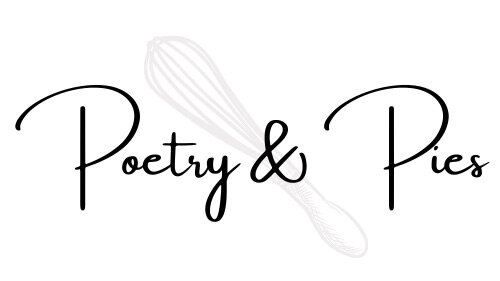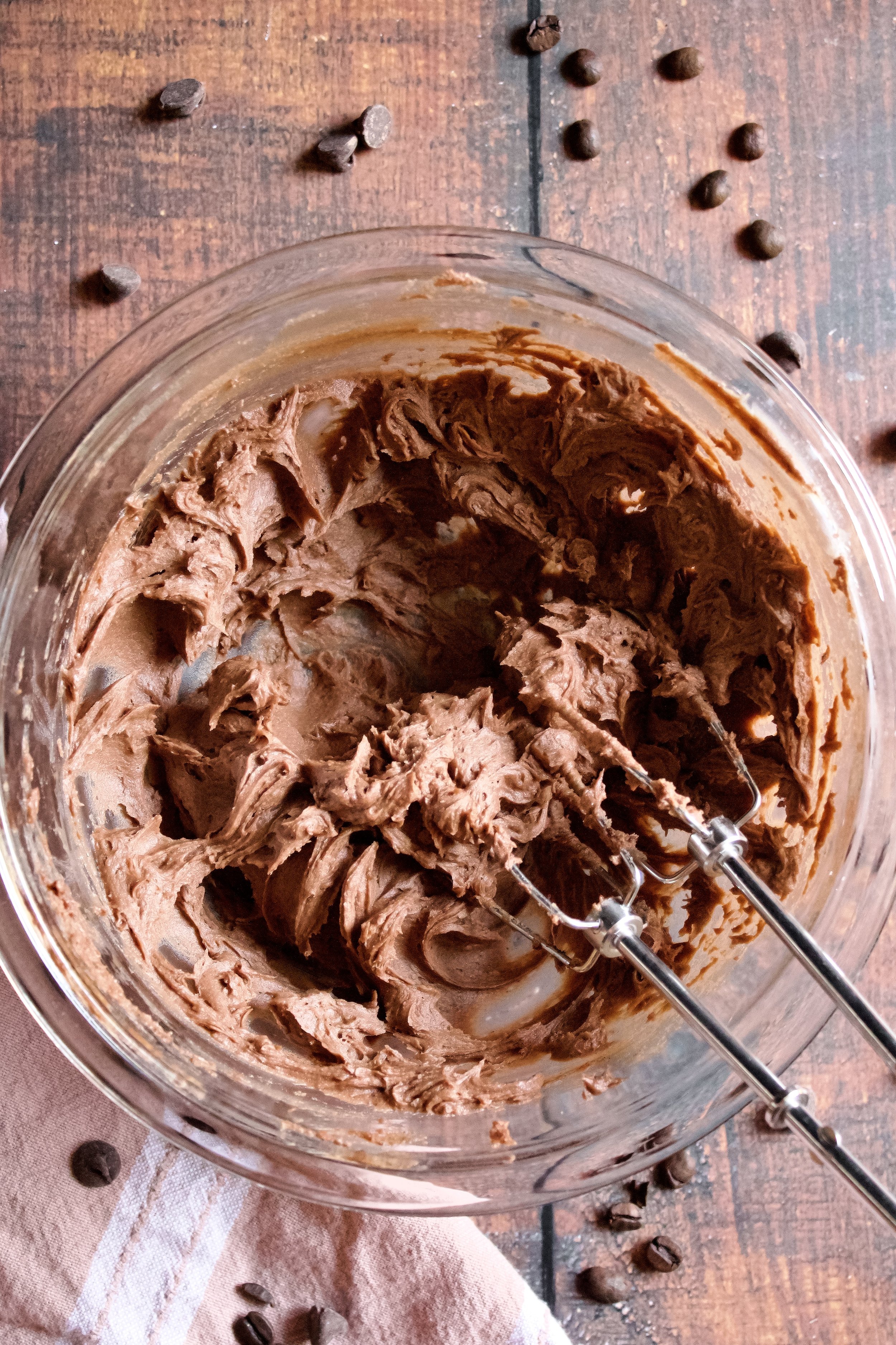Chocolate Mocha Buttercream
Rich, smooth chocolate buttercream with a strong hint of espresso. This simple addition to your chocolate buttercream will be a hit with coffee lovers!
This post may contain affiliate links from which, at no additional cost to you, I may earn a small commission to keep this site running. Only products I myself would or do use are recommended.
Hi friends! It’s been a hot second since I last posted. I’ve been wrapped up in a teething toddler and grading research papers, and my brain kinda hurts most days. But wow do I love my students. They have been a source of joy and even energy each day, despite how much work I’ve been pouring into teaching this year. Or maybe because of how much I’ve poured into teaching. To watch their writing and critical thinking grow so much, to see them find learning interesting and to want to know more—it’s such a joy.
(And yes, I also love and adore my daughter, despite the eruption of a molar before the cuspids—this child is stretching my strength daily, but I love her to pieces.)
Anyway, I wanted to share this frosting weeks ago, because it pairs so well with my chocolate cake and raspberry jam and soon I’ll share my chocolate raspberry mocha cake!
Why this recipe works
The pairing of chocolate and espresso is pretty classic, but the keys are 1) high quality instant espresso or coffee and 2) adding the coffee and cocoa to taste. I typically add about 2/3 of the powdered sugar I plan to use, then I add in the cocoa and espresso and mix well. At this point, I stop and taste it, adding more cocoa and/or espresso powder until I’m happy with the taste. I also like to add some heavy cream at this point, to help the espresso dissolve as I’m mixing. It will continue to dissolve as you whip the frosting, but the heavy cream early on is really helpful to the overall texture.
Key ingredients
Butter. I always use European style butter in my frostings, but it’s especially helpful in this recipe, as you don’t want to lose too much volume in the browning process (to water evaporation). Unsalted butter is ideal, as salted butter can sometimes create a metallic taste when browned.
Powdered sugar. Also known as icing or confectioner’s sugar. This is added to taste, as browned butter can turn out a little differently each time, which will affect how much sugar you really need.
Vanilla extract. Use pure extract, not imitation.
Instant espresso (or Instant coffee). Either one works well, although it’s easier to find instant coffee.
Unsweetened cocoa powder. I do suggest sifting it. And using a high quality cocoa is helpful to creating a well-rounded, rich flavor.
Salt. Omit if using salted butter.
Heavy whipping cream. This is to smooth out the frosting, which is especially needed in this recipe due to the browned milk solids and altered overall texture of browned butter.
How to make cinnamon spice buttercream
1. Beat butter. Be sure your butter isn’t too soft—it shouldn’t be melty or very shiny.
2. Slowly beat in powdered sugar. Do this about a cup at a time, scraping the bowl as needed.
3. Add sifted cocoa and instant espresso. Sifting the cocoa helps prevent clumps, since a smooth frosting is important!
4. Add vanilla, salt, and heavy cream. Heavy cream is technically optional, but I found it’s really helpful in this recipe to dissolve both the cocoa and espresso.
5. Adjust flavors then beat until smooth. You can add more powdered sugar, cocoa, espresso, or heavy cream, if needed. Do this in small increments so you don’t overdo it. Then beat on medium-high for a few minutes until very light and fluffy.
6. Stir to remove air bubbles. You can use your mixer on lowest setting for a few minutes or stir vigorously by hand for a minute or two. Just be sure those air bubbles are gone!
Enjoy!
Tips and FAQ’s for this recipe
How do I get the espresso powder to dissolve fully?
In my plain coffee buttercream, I actually call for dissolving the powder in boiling water. However, I’ve found that it dissolves almost entirely if you add some heavy cream right after beating in the espresso powder, and any granules that are left aren't visible due to the cocoa. However, if you need a super smooth frosting for your decoration, you can follow the same directions. I recommend dissolving 1 teaspoon espresso in 1 tablespoon boiling water to start. If it is not strong enough, you can repeat this process, but you’ll have to wait for this to cool before using it.
What kind of cocoa should I use?
Since there is no baking (and thus no chemical reaction) involved, your favorite kind of unsweetened cocoa or cacao powder will do for this buttercream. We actually buy an organic, fair trade cacao powder from Costco that I love. I also love the Trader Joe’s Cocoa Powder, because it’s rich and dark without being bitter, and I believe they have a cacao powder as well. Another of my favorites is Ghirardelli, because they have plain cocoa, dark cocoa, and even premium. And, while I don’t care for Hershey’s chocolates or their syrup, I do love their Special Dark Cocoa Powder if I want to make a richer buttercream.
What kind of espresso should I use?
I have used King Arthur Instant Espresso before and really liked it. However, I have to order it, and that kind of thinking ahead just isn’t always in my skillset. So, I will often sub instant coffee from Starbucks (I’ve found it at Starbucks itself and at my local grocery store). I’ve had good luck with all blends of instant coffee from Starbucks (just not the sweetened ones!), but Pike Place is a pretty reliable one. There are plenty of high quality instant coffee options out there now, so feel free to try some out!
Can I use salted butter?
Yes, but you probably won’t need any salt in that case. It really depends on the brand. I often use Kerrygold salted butter and only add a pinch of salt for a double recipe of frosting, so taste as you go and use your better judgment on adding additional salt.
Do I have to stir it at the end?
Yes! It’s best practice to beat your buttercream on high or medium hight for at least a minute after everything is to your liking. It really does create a creamier frosting. However, it also creates bubbles (womp womp). So you need to stir those bubbles out, and doing this by hand is the best method I’ve seen so far.
Take your time adjusting the flavors
If you add too much maple extract (which is easy if you don’t use a measuring spoon), it will be overwhelming and sickly tasting. Or, the absolute worst, is adding too much heavy cream. You can easily turn American buttercream (which is what this is) to soup or cause it to break (i.e. separate) by adding too much liquid, such as heavy cream or coffee. So, use a light hand and have the patience to take an extra 5 minutes adjusting the flavors. In the end, you’ll love the result and get to taste test more frosting.
Refrigerate overnight if possible
When you refrigerate buttercream, it helps smooth it out quite a bit. Plus, it helps the flavors deepen. Since each brand of malt powder is different, you may feel like your buttercream is grainy. Covering it and putting it in the fridge overnight then giving it a good stir once it comes to room temperature is really helpful in smoothing out any remaining graininess.
Do I have to use European butter?
Personally, I think it makes a huge difference. It’s creamier and has a very different consistency than sweet cream butter. Since you only have a few ingredients here, you want to make sure each one is of the highest quality. But don’t worry—you can often find it at places like Costco on sale!
My tools
Here are my must-have tools I use for making this buttercream. Affiliate links provided.
1M piping tips (for piping rosettes)
Offset spatula (if frosting a cake)
Chocolate Mocha Buttercream
- total time: 10-15 minutes
yields: about 2 ½ cups (enough to frost a 2-3 layer cake or 24 cupcakes; if doing extra piping or a larger cake, make a 1.5 recipe)
Ingredients:
- 1 ½ cups (12oz) unsalted European style butter, softened*
- 4-5 cups (520-650g) powdered sugar
- 4-6 tablespoons (28-42g) unsweetened cocoa powder, sifted
- 1-2 teaspoons (2-4g) instant espresso or coffee powder**
- 1 tablespoon (13g) pure vanilla extract
- ¼ teaspoon (3g) sea salt (or ½ teaspoon table salt)
- 2-4 tablespoons (28-56g) heavy whipping cream
Instructions:
- In the bowl of your stand mixer fitted with the paddle attachment (or in a large bowl using a handheld mixer), beat butter on high until smooth, about 30 seconds.
- Add in powdered sugar, one cup at a time, beating on low then increasing speed to high for 1 minute, until smooth. Scrape the bowl as needed. Taste as you go and only add as much powdered sugar as needed. You can add more after the cocoa powder if it’s necessary.
- Use a medium fine mesh sieve to sift the cocoa into the bowl, starting with just 4 tablespoons (or ¼ cup), and the espresso powder, starting with just 1 teaspoon. Beat until smooth then taste, adding more cocoa and/or espresso powder if desired. If needed, add 1 tablespoon of heavy cream at this point to help smooth the frosting and encourage the espresso to dissolve. It will continue to dissolve when you beat it in step 7.
- Add in the vanilla extract and salt and beat until smooth.
- Scrape down the bowl and taste again. Add more powdered sugar, cocoa powder, or espresso powder to taste. But do this slowly and trust your gut if it tastes good as-is.
- If it’s too thick or grainy, add in heavy whipping cream, one tablespoon at a time, until spreadable. Don’t worry if it’s a little grainy--the next step will help with that. Don’t add too much cream, as it’s impossible to recover from making it too loose.
- Once the flavor is well-balanced and to your liking, scrape the bowl then beat on high for 3-5 minutes, stopping once to scrape down the bowl. This will smooth it out quite a bit. Stir vigorously by hand for a minute to release the large air bubbles.
- Note: if, after beating for 5 minutes and adding some heavy whipping cream, it’s still too grainy, you can refrigerate it for a few hours or overnight. This helps smooth out almost all frostings. Just remember to let it come to room temperature on the counter then stir well before using.
Enjoy!
Frosting can be made ahead and stored in the fridge in an airtight container for up to 2 weeks or in the freezer for up to 2 months. Let come to room temperature on the counter then stir well before using.
*If your butter has become shiny or oily, put it back in the fridge for 5-10 minutes until it firms up a bit (not hard) and is matte in appearance.
**See note above for dissolving espresso in boiling water to get an even smoother frosting.











